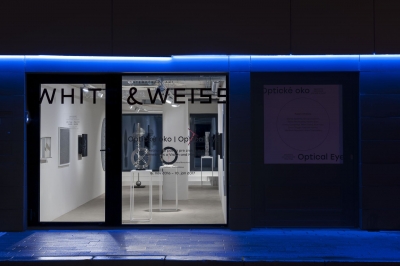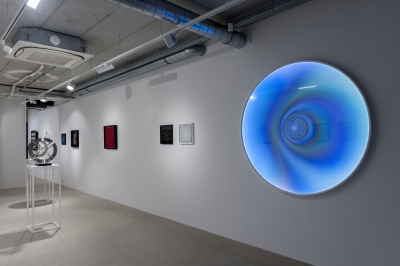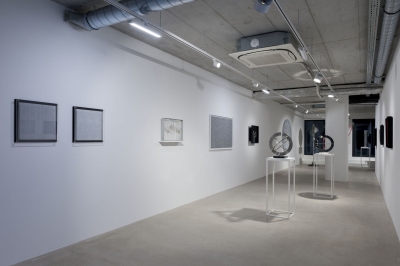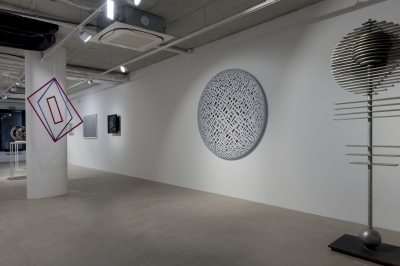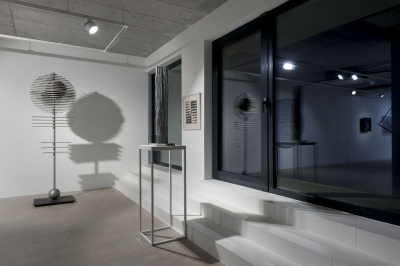
Optical Eye
Geometry - As a Vision and Mind Trap
16th November 2016 – extended until 12th January 2017
Tue - Fri 13:00-18:00
Grösslingová 50, 811 09 Bratislava
Artists: Marina Apollonio (1940), Bernard Aubertin (1934), Štefan Belohradský (1930 - 2012), Alberto Biasi (1937), Franco Costalonga (1933), Milan Dobeš (1929), Ašot Haas (1981), Ennio Chiggio (1938), Radoslav Kratina (1928 - 1999), Manfredo Massironi (1937 - 2011), Adam Szentpétery (1956)
Curator: Ivana Moncoľová
The expression ‘spectacle’ (in the sense of a striking performance or display) involves the human sight, viewing, appearance and meaning of artwork. Perception is key here. Optical illusions have been popular with several artistic movements - be it impressionism, which created the illusion by the skilful employment of colour, or realistic paintings trompe l´oeil deceiving the viewer by creating the illusion of space and volume. Optical illusions are based on simple geometric shapes, their superimpositions or clusters, creating an illusion of space, movement, source of light and effects such as the moiré pattern – interference of two regular and similar patterns, which, if used in a circular shape, evokes the feeling of infinite warping space. A two-dimensional picture simulates a three-dimensional space and a three-dimensional static object pretends to be moving. In order to work, these pictures require but simple interaction from the viewer – he needs to move in space when viewing the artwork. When perceiving the pictures, human brain quickly switches between two static patterns and so tricks the mind into thinking they are three-dimensional (principle of stereoscopy, perfected by the virtual entertainment business).
Education has trained both the human eye and the mind in ways which enable the spectator to appreciate these visual traps as a form of artistic expression. The 1960’s were the era when the general public became increasingly exposed to this type of art. The artistic movement using geometric and optical effects was presented by New York’s Museum of Contemporary Art in 1965 under the title The Responsive Eye. It included the works by the Italian Gruppo N or Il Gruppo Enne (A. Biasi, E. Chiggio, T. Costa, E. Landi, M. Massironi), some of which have included in the Optical Eye exhibition.
Geometric, constructivist and optical tendencies can be found in Russian art of the 1920‘s (constructivism) and the Parisian scene of the 1950’s (op-art and international artists exhibiting at the Denise René gallery). In the first half of 1950’s, these tendencies have spread, with (geometric) abstraction entering the scene as the successor of early (bold) avant-gardes. They persevered amidst continuing technical developments and inventions eagerly adopted by the general public. Art saw the light of day mainly because of the artist’s need to connect mathematic thinking with art, and it embodied artist’s individual quest for universal order in calculations, physical phenomena seen through the prism of art and artistic works. The artist communicates with the spectator on a non-verbal level through his work, which creates new imaginary spaces using optical effects and visual illusions, alludes to movement and mimics the existence of light emitted primarily from purely static geometric elements. Even today, this type of communication captures the interest of onlookers as a type of spectacle and represents a time-tested investment.
In the early 60s, the dynamic of social development and the exploration of space had been the subject of both day-to-day and scientific discourse. People had been fascinated by coming face to face with industrial technology and tried to humanise it. All this provided space and personal driving force for people such as Milan Dobeš, Štefan Belohradský, Radoslav Kratina and others, who entered the Czechoslovak artistic scene in the first half of 1960’s. At that time, Czechoslovak geometric art and neo-constructivist tendencies and kinetic art captured the attention of the rest of the world (the authors showed their work in May and August 1969 at Nove Tendencije 4 (New Tendencies 4 in Zagreb – an exhibition held in 1961 – 1978 showcasing programmed art and new art as the driving force behind social and political advancement, within the boundaries of western rules). What is interesting is that after August 1968, Slovak and Czech artists did not personally attend the exhibitions; instead they were represented by their works that were handpicked by foreign curators or Slovak curators living in exile.
Displaying Czech and Slovak artists (Milan Dobeš, Štefan Belohradský, Radislav Kratina) next to Italian artists such as Marina Apollonio, French Bernard Aubertin, Alberto Biasi, Franco Costalonga, Ennio Chiggio, and Manfredo Massironi has a purpose – the younger generation of Italian artists (compared to the Czechs and Slovaks mentioned) displayed their works here as early as 1968 at the International Bienale of Young Artists Danuvius 1968 (Italians G. Alviani, A. Biasi, A. Bonalumi) or at a concretist exhibition in Žilina in March 1968 (P. Dorazio, J. Le Parc, F. Morellet, J. R. Soto, to name a few).
When speaking about The Optical Eye exhibition, we must not forget to mention the artistic achievements and acceptance Milana Dobeš’s artwork garnered from the audience both east and west of Czechoslovakia’s border in the 60s. His work came into the spotlight when he started to work with German art theoreticians U. Kultermann and F. Popper, who first discovered his works at the artist’s individual exhibition in Prague in 1966. Since 1968, both German curators exhibited his works abroad, presenting him to the audience as the founder of kinetic art. He was part of Dokumenta 4, one of the most prestigious art exhibitions, held in Kassel, Germany. With the transition to the normalization years of the 70s, active cooperation with artists in other parts of the world was drastically cut. One of the few major displays of this art was the exhibition at the World Expo in Osaka 1970 where the Czechoslovak pavilion presented the works of Š. Belohradský, M. Dobeš, A. Klimo and R. Uher, S. Libenský, J. Brychtová, R.Roubíček and others). For Milan Dobeš, Osaka came to be the incentive to produce a series of performative lighting and kinetic concerts in the USA in July 1971, composed to the music of T. Mayuzumi (Concert for percussions) and K. Penderecki (Pittsburgh Overture) as part of the American Wind Orchestra.
In the 60s, Czechoslovak artists were intent on expressing their artistic views in the form of constructivist objects, glowing pictures and sculptures that generated and mimicked movement. Both local (Arsén Pohribný, Jiří Valoch, Josef Hlaváček, Tomáš Štrauss) and foreign curators (Udo Kultermann and Frank Popper) took an interest in them. The connections between the Czech and the Slovak artistic scene had grown even more intense after the founding of the 1967 artistic grouping called Klub konkretistov (1967) (initiated by Arsén Pohribný). After 1970, it was the Czech artist Radoslav Kratina who became the informal leader of the grouping after he had introduced democratic methods of communication among its members. Thanks to exchanging his views by way of corresponding with fellow artists, he contributed to nourishing creative tendencies among the art scene.
Some of the works displayed at The Optical Eye exhibition date back to the 60s and contemporary art; they reference and employ the principle of optical traps, which deceive the eye and the mind of spectators. The works selected all use optical illusions and play with our mind’s experience, which is capable of distilling the effect of the illusion.
Art should trigger a response the very moment it comes into existence, and this is when it is able to touch the spectator most intensely. This is the reason the exhibition shows younger generation of Slovak artists in the company of world-renowned artists. Adam Szentpétery is part of the younger generation that entered the artistic scene in 1980’s. He creates space with help of intense painting elements, putting line, colour and surface into action. His circular paintings evoking the possibility of there being further space behind the primary colour lines captivate the observer. Paradoxically, when creating his work Szentpétery uses original and traditional painting techniques, drawings and life-size cardboard models, all this at a time when computers offer so much in terms of animating space. His pictures are time-consuming, but extremely alluring and with only a reduced range of variations, he manages to yield an ever so unique result.
Another younger but very prominent figure is Ašot Haas – he often uses artistic ideas heralded by the older generation of artists who worked with geometry, but throws an intense and functional technological aspect into the mix. His works tiptoe on the verge of painting, object and design. His lighting, pulsating pictures, huge glass lenses with the pattern of a diamond or lighting objects changing colours across the colour spectrum build on the technical comfort of today’s viewer and collector. The optical effect he creates results from the artist toying with the viewer, stimulating interactivity and enhancing perception of the object. He wants the viewer to eventually be consumed by the experience. The works of Ašot Haas wrap up this partly historic half-a-century long excursion and offer an opportunity to look back at the very beginning and realise how far artistic invention is able to push basic geometric shapes and optical principles.
Photo of exhibition: Marko Horban
